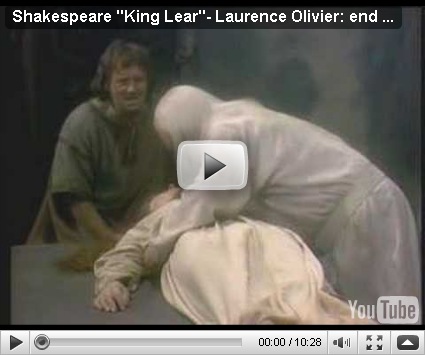When I was just out of college and getting into Shakespeare independently, I got it into my head to watch the best. This was some time right around when Mel Gibson did Hamlet, so I think I wanted something to compare it to. So, naturally, I got a VHS tape of Laurence Olivier as King Lear. Honestly, I never finished it. I’d never read the play at this point and I simply couldn’t follow it. Funny how time changes us. Here is the end of the play where Lear, a ghostly shadow of his former self at this point, carries the lifeless body of his daughter back on stage …
(*Note attention to detail – they actually put a scar around Cordelia’s neck!) I’m intrigued by the “howls”. Here, Olivier does manage to make near animalistic noises, but he’s still articulating the word “howl”. I always wondered if perhaps this was the equivalent of an “o-groan”, something to be taken more as a stage direction (“Enter howling”) than actual script? I think the interaction between Kent and Lear is excellent, how he so conversationally gestures to him with that “what is your name? you look familiar…” as if it’s just a normal interaction, and yet how he does not make the Caius connection and thinks Caius dead. Ok, need to stop, the “Cordelia, stay a little…what does thou say?” just brought tears to my eyes. Wow.


Olivier accepts the "license to act" given him by Shakespeare through repetition. He never writes anything more than once in sequence without a purpose. It more times than not has to do with giving the actor freedom to explore the emotion. And you're right; much as the "O" is a cue to "act", so the repetition of the "Howl" four times. It's even immediately followed by an "O". In the Folio, there are only three howles, then one O. All are single syllable, strong stresses.
"Howle, howle, howle: O you are men of stones,". Either way, the point is made to the actor.
I think it's important to clarify…
An "O' or repetition of a particular word, though it can be considered "direction", doesn't mean the word is meant to be ignored by not articulating it–somehow. Perhaps the most famous repetition of a word in Lear is his perfect trochaic line "Never, never, never, never, never." Though we can look at it as "stage direction" of sorts, to ignore the words would be going too far with the license.
In terms of "direction" within the line, the structure and punctuation of the "howl" line in the Folio is ignored by even Oxford and Norton in their additions (one of which is claimed to be the 1623 Folio in the Norton), which add another "howl" in the place of a colon following 3 howls. This seems to be an apparent attempt to make the line scan *properly* with ten beats instead of the nine as it's written in the Folio. But there ARE ten beats in the Folio (adding the acting cue of the colon, which can be interpreted as either a pause or an indication for movement; in either case a place for a transitional shift within the body of the line which takes up time). So, technically speaking, Olivier actually takes more time with his last animalistic Howl than was originally written. But then, he was often chastised by some for taking "liberties" with the text. 🙂
More than some might be interested in thinking or worrying about, I admit; but vitally important when it comes to interpreting the tempo of the text and the rhythmic variations within it. Ultimately it has a direct affect on what the audience is given, which is of the utmost importance.